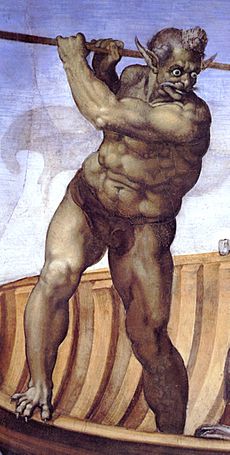Charon (mythology) facts for kids
In Greek mythology, Charon (pronounced KAIR-on) is a very important figure. He is known as the ferryman of Hades, the god of the underworld. Charon's main job was to carry the souls of people who had just died. He would take them across the rivers Styx and Acheron. These rivers were believed to separate the world of the living from the world of the dead.
People in ancient Greece sometimes placed a small coin, like an obolus, in or on the mouth of a dead person. This coin was meant to be payment for Charon to take their soul across the river. Archaeologists have found small, low-value coins in some ancient burials. These coins were often found near the mouth of the person or next to their ashes. This shows that the practice was real.
Contents
Who Was Charon's Family?
Charon was believed to be the son of Erebus. Erebus was a god who represented darkness. Charon also had many brothers and sisters. These included Thanatos, who was the god of death, and Hypnos, who was the god of sleep.
How Charon Looked and Acted

Charon is often shown in the art of ancient Greece. Many ancient Greek pots, especially those used for funerals, show scenes of dead people getting onto Charon's boat. These pots were made in Athens during the 5th and 4th centuries BC.
On older pots, Charon looks like a rough, ordinary Athenian sailor. He is usually dressed in reddish-brown clothes. He holds his long ferryman's pole in his right hand. With his left hand, he reaches out to take the soul of the person who has died. On newer pots, Charon is sometimes shown with a kinder and more gentle look.
Later, in his famous poem Divine Comedy, the writer Dante described Charon. Dante wrote that Charon had eyes of fire. Charon is the first mythical character Dante meets when he enters the underworld in the poem.
Charon in Space
One of the largest moons of the dwarf planet Pluto is named after Charon. This moon is called Charon.
Charon in Dinosaurs
A type of dinosaur called Charonosaurus is also named in Charon's honor. This dinosaur was a hadrosaurid, or "duck-billed" dinosaur. It was found along the banks of the Amur River in the Far East.
See also
 In Spanish: Caronte (mitología) para niños
In Spanish: Caronte (mitología) para niños


